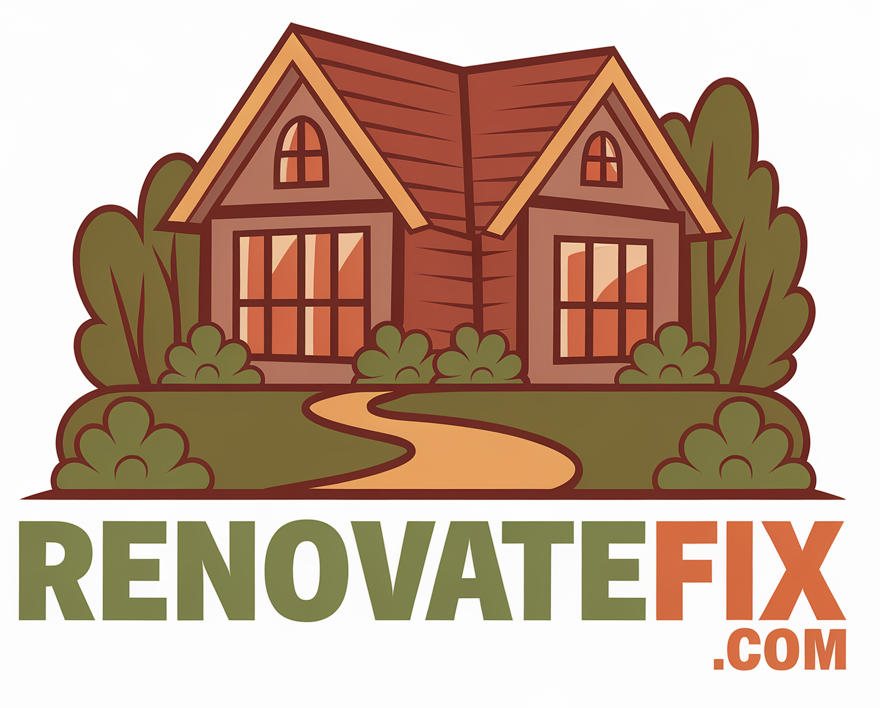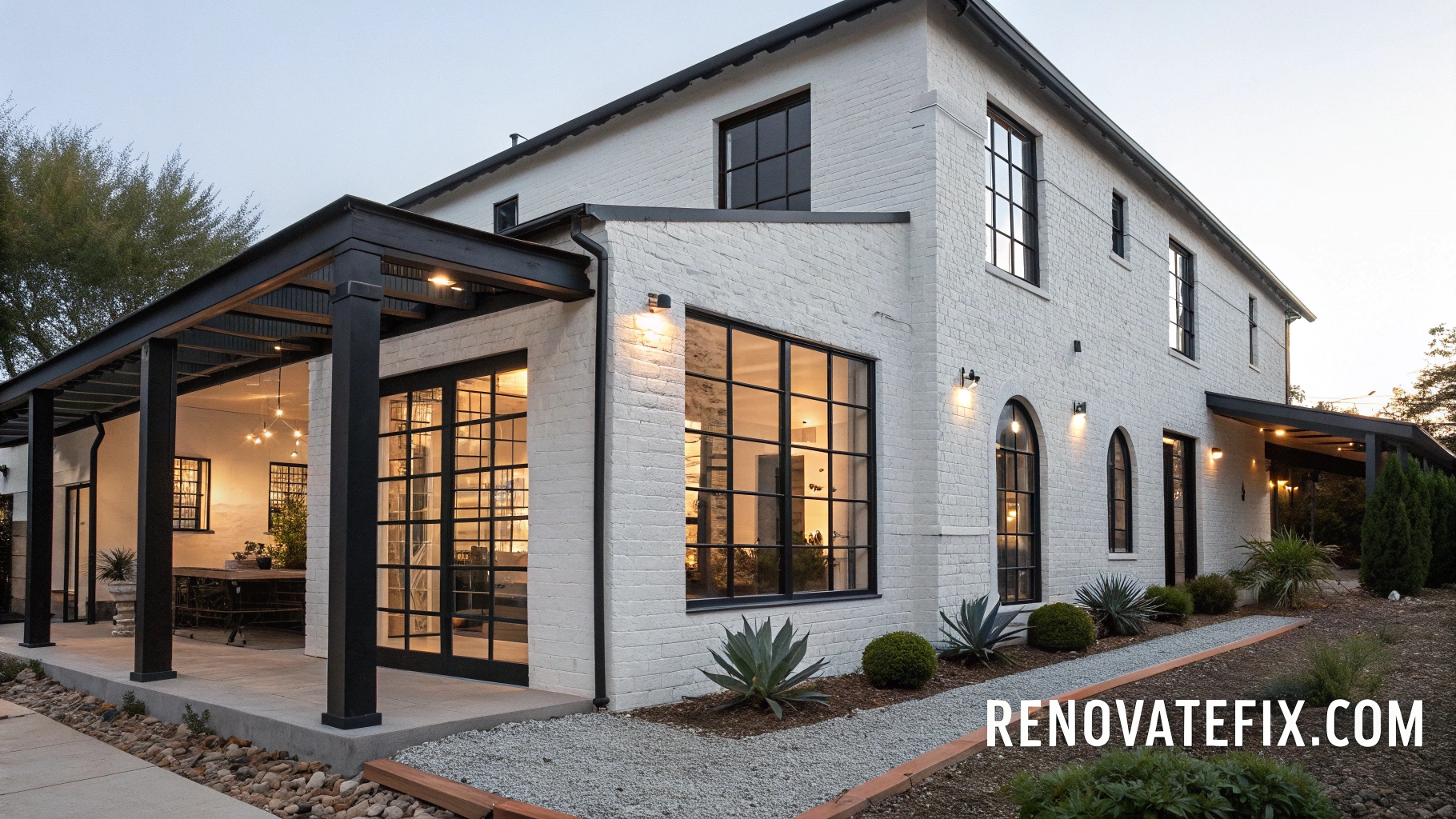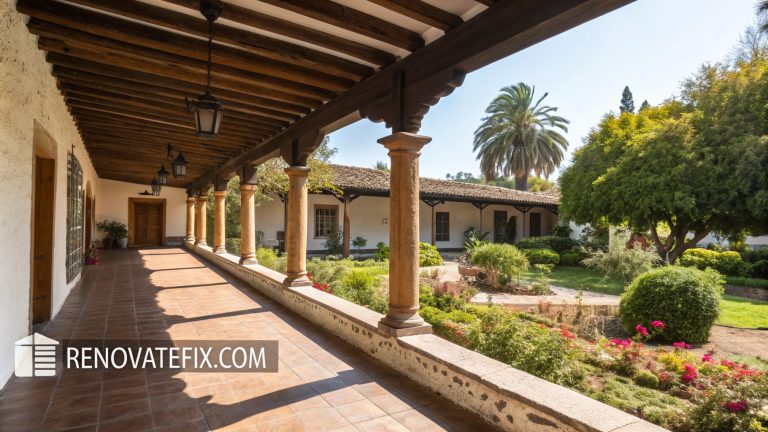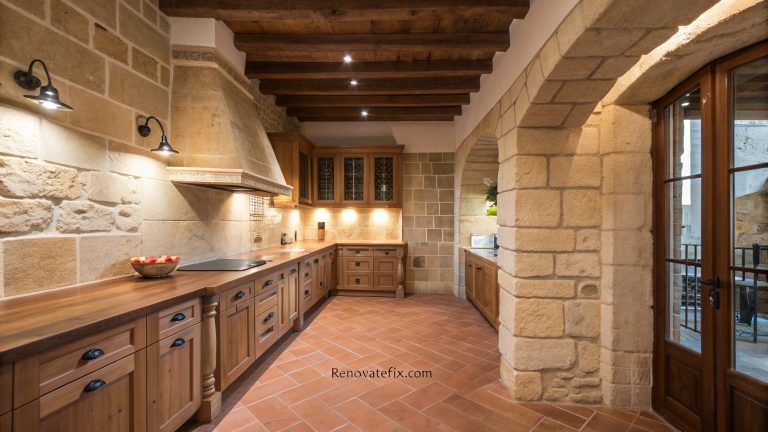20 Elegant White House Exterior Designs to Enhance Your Home’s Curb Appeal
The exterior of your home creates a lasting impression and sets the tone for what lies within. A white house offers timeless elegance, versatility, and endless possibilities for customization.
Whether you own a classic colonial, a modern farmhouse, or a minimalist bungalow, the right exterior touches can dramatically elevate your home’s appearance and value.
In this comprehensive guide, we’ll explore twenty distinctive white house exterior concepts that balance tradition with innovation, helping you discover the perfect aesthetic for your residence.
From stunning facade materials to complementary color accents, landscaping elements, and architectural details, these ideas will inspire you to reimagine your home’s exterior potential.
1. Classic Colonial Revival
The stately presence of Colonial Revival architecture paired with pristine white siding creates an enduring, sophisticated aesthetic that never goes out of style.

Black shutters frame windows symmetrically positioned around a centered front door, while columns support a pronounced portico that draws attention to the entrance.
Brick pathways leading to the front steps add warmth against the crisp white background, establishing a welcoming approach that honors historical architectural traditions while maintaining a fresh appearance.
2. Modern Farmhouse Charm
Bright white board-and-batten siding creates a striking canvas for black-framed windows and natural wood accents that define modern farmhouse style.

A metal roof adds industrial flair while providing durability and distinctive visual texture against stark walls.
Wraparound porch with simple wooden columns offers functional outdoor living space and architectural interest, complemented by minimal landscaping featuring native grasses and strategic greenery that enhances rather than overwhelms the clean lines.
3. Mediterranean-Inspired Elegance
Smooth stucco exterior painted in warm white evokes sun-drenched coastal villas, complemented by terracotta roof tiles that add rich color contrast and Old World character.

Arched doorways and windows create architectural rhythm and soften the facade’s appearance, while wrought iron details on balconies and light fixtures contribute artisanal craftsmanship touches.
Potted citrus trees and climbing bougainvillea introduce vibrant color against the understated backdrop, completing this refined interpretation of Mediterranean aesthetics.
4. Coastal Cottage Appeal
Weathered white shiplap siding captures relaxed seaside character while maintaining structured elegance, paired with pale blue accents on doors and window trim that echo ocean hues.
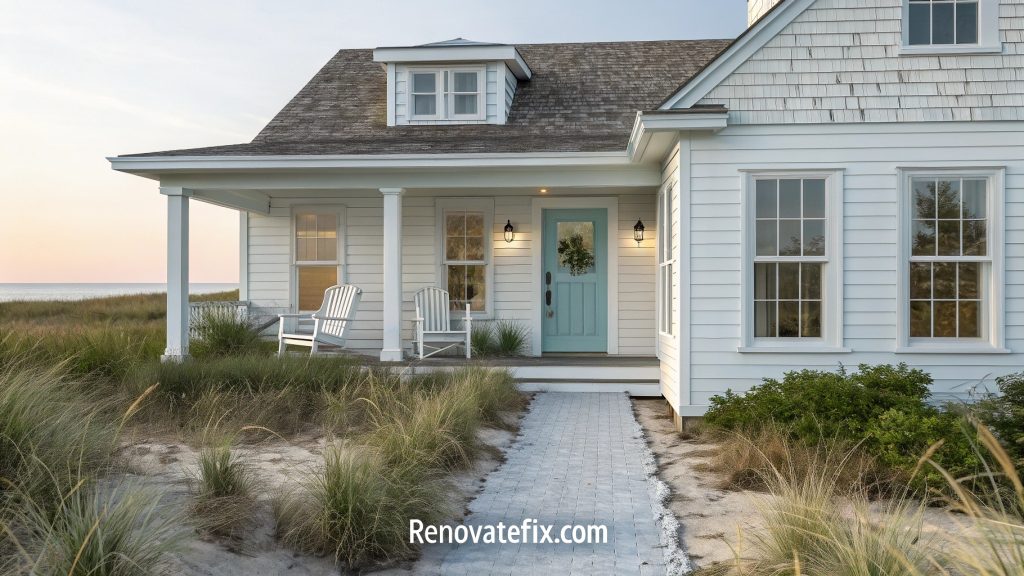
Cedar shake roof adds textural dimension and natural aging properties that improve with time, enhancing the lived-in charm essential to authentic coastal aesthetics.
Shell pathways and native beach grasses create contextual landscaping that reinforces maritime connections, while a generous front porch invites outdoor relaxation while protected from sun and elements.
5. Minimalist Cubic Architecture
Stark white geometric volumes create bold architectural statements through form rather than ornamentation, with strategically placed windows functioning as compositional elements within blank surfaces.

Flat rooflines maintain pure geometric integrity while promoting clean shadows and light play across facades throughout daylight hours.
Concrete walkways with precise linear design emphasize intentional simplicity extending from structure to landscape, while focused spotlighting dramatically highlights architectural features after sunset, bringing nighttime drama to daytime restraint.
6. Tudor Revival Sophistication
White painted brick offers fresh interpretation of traditional Tudor styling while maintaining characteristic half-timbering details in contrasting dark finishes.

Diamond-patterned leaded glass windows reference historical accuracy while filtering light beautifully into interior spaces, surrounded by distinctive steep gabled rooflines that create dramatic silhouettes against sky.
Manicured formal gardens featuring boxwood hedges and symmetrical plantings complement architectural formality, establishing period-appropriate setting for this dignified residential style.
7. Ranch Renovation Success
Horizontal white clapboard siding modernizes mid-century ranch homes while maintaining appropriate period aesthetics, expanded by wide front porches that create transition zones between indoors and outdoors.

Oversized planters containing architectural plants frame entrance points with living sculptures that add height variation to predominantly horizontal structures.
Mixed materials incorporating stone veneer bases anchor light upper portions to ground, creating visual weight balance while nodding to Prairie School influences found in many original ranch designs.
8. Rustic Alpine Inspiration
Snow-white exterior walls contrast dramatically with natural wood beams and support structures expressing authentic chalet construction methods adapted for modern homes.
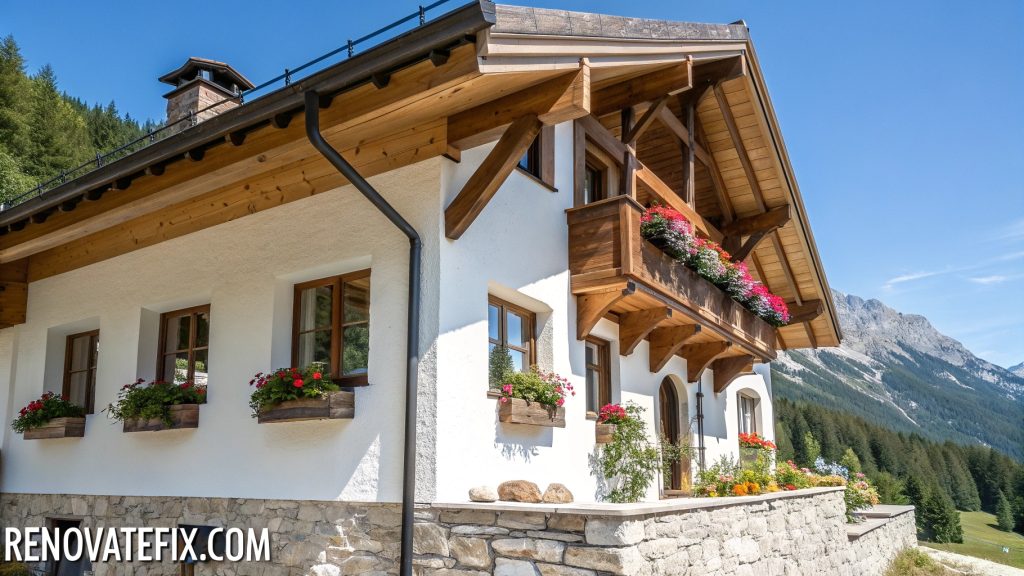
Deep overhanging eaves provide practical protection from weather elements while creating strong shadow lines that enhance architectural dimension throughout day.
Window boxes bursting with colorful alpine flowers add vibrant counterpoints to pristine walls during growing seasons, while stonework foundations visually root structures to mountainous settings through material connection to natural surroundings.
9. Greek Revival Grandeur
Monumental white columns supporting front porticos create unmistakable classical presence reminiscent of ancient temples adapted for residential architecture.

Perfectly proportioned windows arranged with mathematical precision maintain formal balance central to Greek Revival philosophy, surrounded by detailed cornices and pediments showcasing fine craftsmanship through decorative millwork.
Symmetrical landscaping featuring ancient olive trees reinforces Mediterranean origins of architectural inspiration, while gravel driveways provide appropriately understated approach to impressive facades.
10. Art Deco Brilliance
Smooth white stucco surfaces provide ideal canvas for geometric Art Deco detailing that creates visual rhythm across facades through repeated motifs.
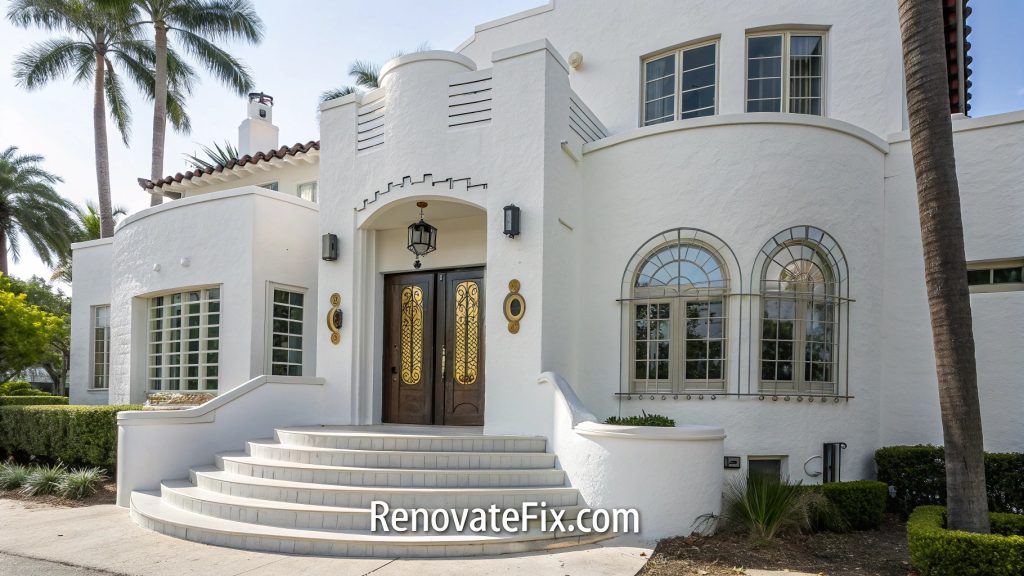
Decorative metalwork in brass or chrome finishes introduces luxury materials as architectural accents around windows and entrances, contrasting brilliantly against pristine backgrounds.
Curved architectural elements soften corners while maintaining period authenticity essential to this distinctive 1920-30s style, complemented by palm landscaping that reinforces connections to tropical Art Deco heartlands like Miami Beach.
11. Prairie-Influenced Horizontal Flow
Low-pitched white rooflines with exaggerated overhanging eaves create strong horizontal emphasis characteristic of Prairie School thinking, balanced by stacked stone chimneys that introduce vertical counterpoints.
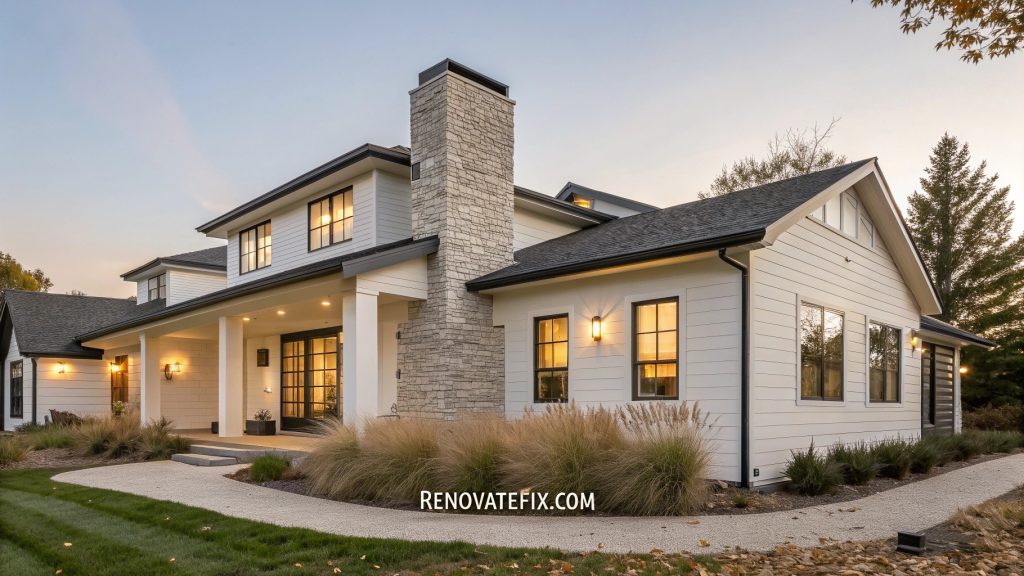
Bands of windows arranged in horizontal groupings maximize natural light while reinforcing architectural direction and connection to landscapes, framed by subtle trim painted slightly darker shade than main walls for dimensional definition.
Native grassland landscaping extends architectural philosophy into surroundings through plant materials that echo horizontal lines found within structure itself.
12. Industrial Modern Edge
White-painted brick combined with raw concrete elements creates textural dialogue between refined and rough surfaces that defines industrial aesthetic adapted for residential applications.
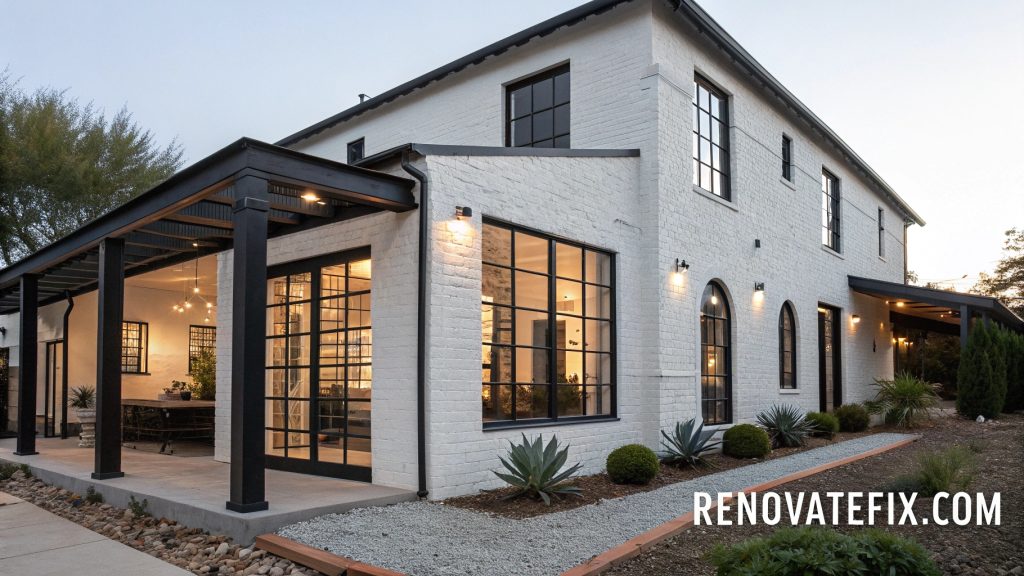
Factory-inspired windows with black metal frames divided into multiple panes reference manufacturing origins while bringing abundant light indoors, positioned beneath exposed steel support beams that celebrate structural components as design features.
Minimalist landscaping featuring crushed stone and architectural succulents maintains industrial vocabulary through material choices and geometric plant forms.
13. Victorian Gingerbread Delight
Bright white paint accentuates intricate Victorian gingerbread trim details that might otherwise visually blend together in more colorful treatments, allowing appreciation of craftsmanship through contrast.

Wraparound porches with ornate railings and turned posts provide both functional outdoor space and opportunities for decorative expression characteristic of period, supported by delicate brackets and spindles displaying woodworking virtuosity.
Strategic color accents on specific architectural details draw attention to particularly important features without overwhelming overall composition, creating visual hierarchy across facade.
14. Southwest Adobe Reimagined
Smooth white stucco exterior mimics traditional adobe construction while providing modern performance benefits, shaped into organic rounded corners that soften building forms naturally.

Turquoise door creates striking focal point through complementary color theory while referencing authentic regional color traditions found throughout Southwest, framed by recessed entrance adding shadow depth to facade.
Xeriscaped desert landscaping featuring carefully arranged cacti and native stone mulch establishes appropriate environmental context while requiring minimal water resources, demonstrating harmony between architecture and natural setting.
15. French Country Elegance
Soft white limewash exterior with intentionally imperfect application reveals subtle undercoats creating depth through transparent layers rather than flat paint finish.
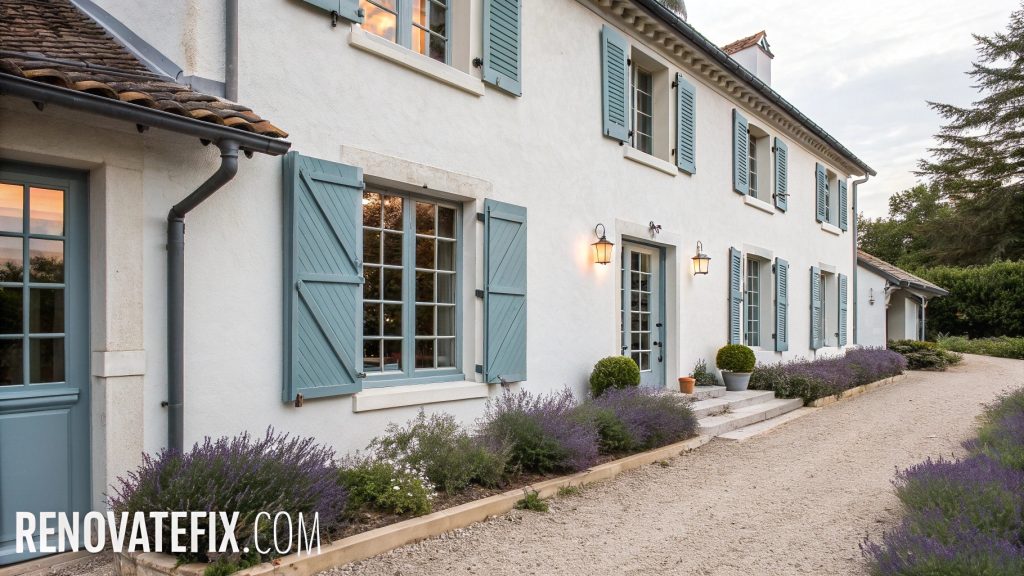
Blue-gray shutters frame windows with authentic proportions designed to actually close during storms, maintaining historical functionality rather than merely decorative application.
Copper gutters and downspouts develop beautiful patina over time that complements weathered white surfaces through parallel aging processes, surrounded by lavender borders and gravel pathways establishing European countryside aesthetic adapted for American settings.
16. Mid-Century Brilliance
Pristine white masonry contrasts dramatically against wall sections clad in rich mahogany panels, creating architectural rhythm through material alternation while honoring mid-century material palettes.
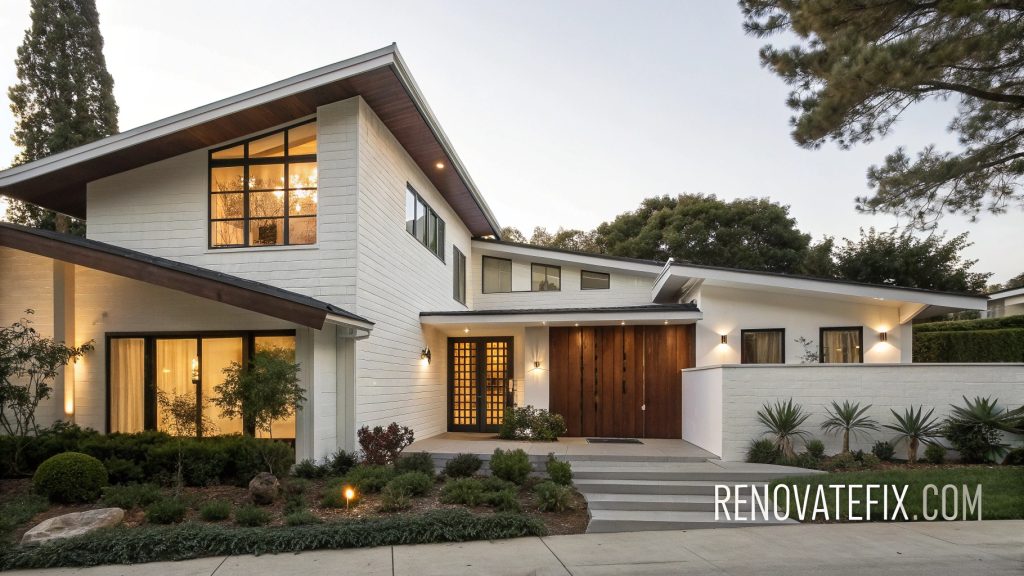
Asymmetrical rooflines with dramatic angles express modern optimism and forward-thinking design philosophy central to era, highlighted by clerestory windows bringing indirect light into interior spaces.
Specimen plantings chosen for sculptural qualities rather than floral displays reinforce architectural emphasis on form over decoration, positioned strategically as living counterpoints to geometric building elements.
17. Craftsman Bungalow Beauty
White-painted wood siding brightens traditional Craftsman facades while maintaining authentic architectural details like exposed rafter tails and decorative brackets.
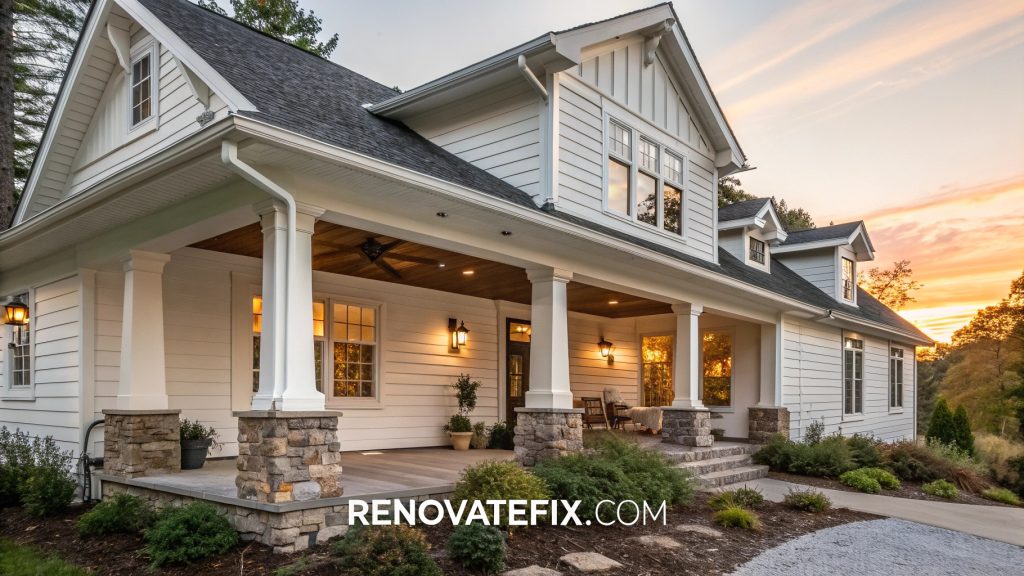
Natural stone columns supporting front porch roof create solid visual foundation expressing Arts and Crafts values of honest materials and visible craftsmanship.
Built-in window boxes designed as integral architectural elements rather than afterthoughts maintain design cohesion across facade, surrounded by informal cottage gardens featuring native perennials that soften geometric architectural forms with organic counterpoints.
18. Gothic Revival Drama
Brilliant white exterior amplifies dramatic effect of pointed arch windows and doors that define Gothic architectural vocabulary, creating striking contrast against dark interior spaces visible through openings.
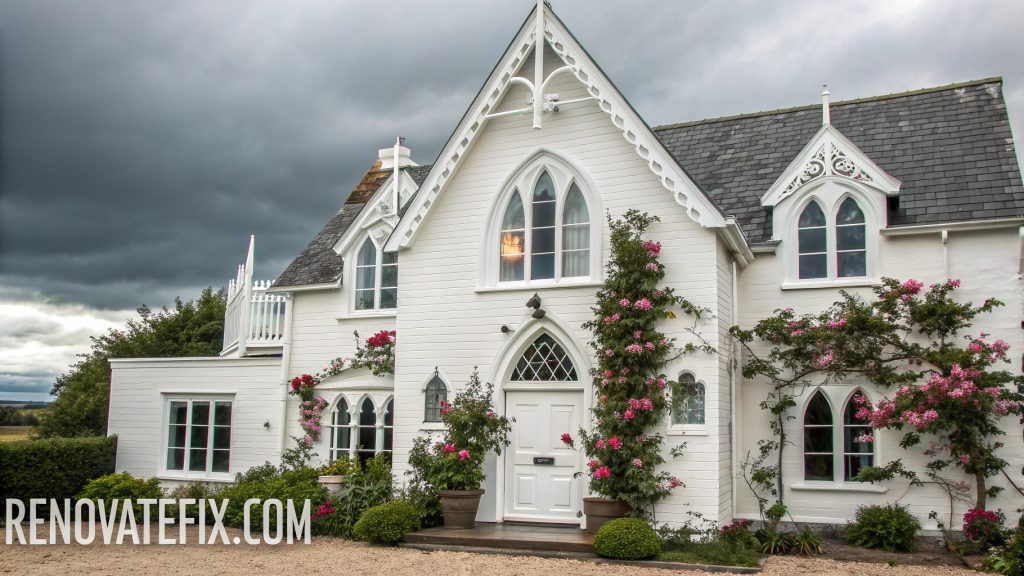
Steep roof pitches with decorated bargeboards create fairy-tale silhouettes against sky while serving practical function of shedding snow and rain efficiently in challenging climates.
Climbing roses trained on trellises soften hard architectural lines while referencing medieval garden traditions appropriate to style, complemented by topiary specimens adding formal structure to landscape design.
19. Lakeside Boathouse Charm
White board siding with navy blue accents captures nautical aesthetic perfect for waterfront properties without resorting to obvious themed decorations.

Large picture windows maximizing water views take design priority over smaller traditional openings, emphasizing connection between interior spaces and natural surroundings.
Dock-inspired deck extending from main structure references boathouse origins through construction methods and materials, surrounded by native shoreline plantings that transition between architectural and natural environments while preventing erosion.
20. Mountain Modern Fusion
Bright white exterior provides stunning contrast against forested mountain settings while visually standing apart from typical rustic brown cabins common to region.

Full-height stone chimney anchors composition while providing visual bridge between architecture and natural rock formations within landscape.
Expansive glass walls framed in minimal black aluminum blur boundaries between interior and exterior experiences, bringing dramatic mountain vistas inside while establishing strong indoor-outdoor connections essential to contemporary mountain living.
Conclusion
The versatility of white exteriors offers extraordinary potential for creating homes that reflect both personal style and architectural integrity.
Whether your preference leans toward historically accurate restorations or boundary-pushing contemporary designs, a white palette provides the perfect foundation for showcasing structural elements, material textures, and thoughtful details.
As you consider these twenty distinctive approaches to white house exteriors, remember that the most successful designs harmonize with both the architectural bones of your home and the surrounding landscape.
By carefully selecting complementary elements—from roofing materials and window styles to landscaping and lighting—you can create a cohesive exterior expression that enhances your property’s curb appeal while providing daily visual satisfaction for years to come.
